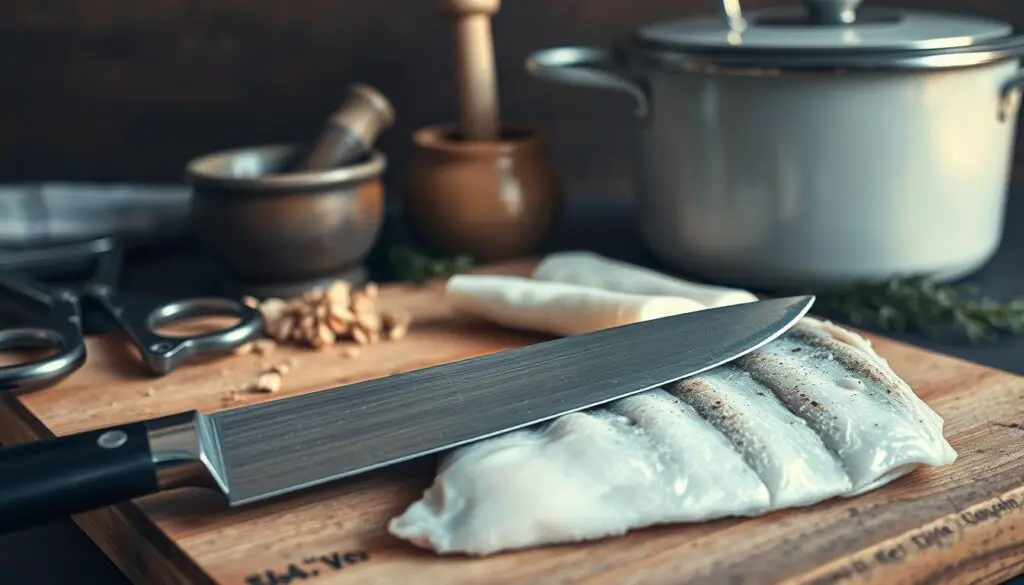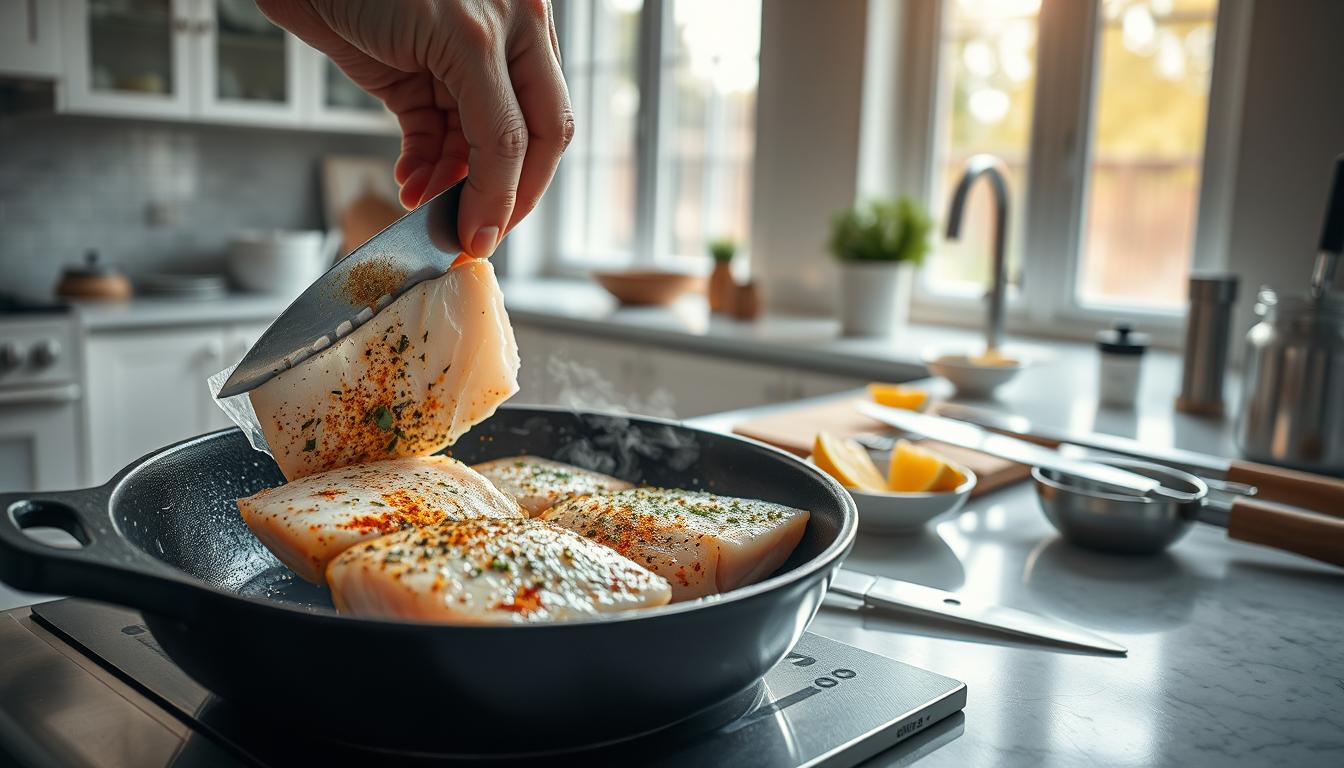Step-by-Step Guide to Cooking Pollock Fish at Home
Every kitchen adventure starts with curiosity. Today, we’re exploring cooking pollock fish. Imagine turning a simple frozen fillet into a tasty meal that excites your taste buds.
Learning to cook pollock fish is more than following a recipe. It’s about discovering a healthy and easy-to-make seafood option. Whether you’re new to cooking or want to improve, pollock recipes are a great start to enjoying seafood at home.
This guide will teach you everything about cooking pollock fish. You’ll learn how to pick the best fillets and master different cooking methods. You’ll make delicious dishes in your kitchen. With just 7 minutes of prep and cooking, you’ll have a meal rich in protein.
We’ll look at various cooking methods, seasoning tips, and easy ways to prepare pollock fish. Get ready to make your home cooking shine and impress your family with top-notch seafood dishes.
Table of Contents
Health Benefits of Pollock Fish
Pollock is a nutritional powerhouse. It’s full of good stuff that’s great for your diet:
- Low-calorie protein source (only 92 kcal per 100g)
- Rich in omega-3 fatty acids
- Excellent source of Vitamin B12
- High selenium content
Nutritional Value and Protein Content
Looking for lean protein? Pollock is your go-to. It has 19 grams of protein per 100g. This supports muscle health and is perfect for a healthy pollock recipe.
| Nutrient | Amount per 100g |
|---|---|
| Calories | 92 kcal |
| Protein | 19g |
| Vitamin B12 | 50% Daily Value |
| Selenium | 40% Daily Value |
Sustainability and Environmental Impact
Pollock’s sustainability is real, not just a claim. Alaskan fisheries follow strict rules to protect the sea. This makes pollock a green choice for seafood lovers.
- Certified by Marine Stewardship Council
- Advanced technologies reduce bycatch
- Abundant species with managed populations
- Affordable seafood option ($2–$4 per pound)
Choosing pollock supports ocean conservation and gives you a tasty, healthy meal.
Essential Tools and Ingredients for Cooking Pollock Fish

Starting to cook delicious pollock fish dishes means having the right tools and ingredients. Your kitchen setup is key to making perfect pollock meal prep experiences.
For successful pollock cooking, you’ll need several key tools:
- Sharp filleting knife
- Cutting board
- Kitchen gloves
- Large bowl of ice water
- Clean kitchen towels
- Measuring cups and spoons
- Cooking pan or baking sheet
When planning your pollock seasoning strategy, stock up on essential ingredients:
- Fresh herbs: Parsley, dill, thyme
- Extra virgin olive oil
- Salt and black pepper
- Garlic powder
- Lemon juice
- Butter or cooking spray
Your pollock fish dishes will shine with proper preparation. Keep ingredients fresh and tools clean for the best cooking results. Remember, having everything organized before you start cooking makes the entire process smoother and more enjoyable.
Pro tip: Invest in quality kitchen tools to elevate your pollock meal prep experience.
Preparing Pollock Fish Before Cooking
Getting pollock fillets ready right is key to making tasty seafood dishes. Knowing the best ways to prepare them will turn these fish into a dish you’ll love.
Thawing Frozen Pollock Properly
Thawing frozen pollock fillets correctly is important to keep their texture and taste good. Here’s how to do it right:
- Take the pollock fillets out of the freezer and put them in the fridge
- Let them thaw slowly in cold water for 30-60 minutes
- Don’t use hot water, as it can ruin the fish’s texture
- Wipe the fillets dry with paper towels before cooking
Cleaning and Deboning Techniques
Cleaning pollock fillets well is important for a great cooking experience:
- Wash the fillets under cold running water
- Check for any bones left behind
- Use tweezers to remove small bones carefully
- Pat the fillets dry with paper towels gently
Basic Seasoning Methods
Pollock’s mild taste is perfect for many seasonings. Here are some easy and tasty ways to season:
| Seasoning Type | Recommended Ingredients |
|---|---|
| Classic Herbs | Parsley, dill, thyme |
| Citrus Zest | Lemon, lime, orange zest |
| Spice Blend | Paprika, garlic powder, black pepper |
Learning these preparation steps for cooking pollock fillets will make your seafood dish delicious and professional. Remember, how you handle and season the fish is crucial for the best taste.
Cooking Pollock Fish: Various Methods and Techniques
Pollock is a versatile fish that offers many cooking techniques. Whether you’re cooking at home or love seafood, learning about pollock cooking can make your meals better.
Baked pollock is a healthy and easy way to cook this fish. Preheat your oven to 400°F and bake the fillets for 10-12 minutes. Make sure the fish reaches 145°F to ensure it’s moist and flaky.
Fried pollock is great for those who like a crispy outside. Pan-frying gives a golden crust and keeps the fish tender inside. Here’s how to do it right:
- Heat oil in a skillet over medium-high heat
- Cook fillets 3-4 minutes per side
- Season with salt, pepper, and your favorite herbs
Grilling pollock adds a smoky flavor. Grill at 375°F for 4-5 minutes per side. Pro tip: Use a fish basket to prevent sticking and ensure even cooking.
When cooking pollock, handle it gently. No matter the method, aim to keep the fish’s flavor and texture intact.
The secret to perfect pollock is temperature control and careful timing.
Try different cooking methods to find your favorite way to prepare pollock. Whether you prefer baked or fried, each method brings a unique taste experience.
Best Seasonings and Flavor Combinations for Pollock
Make your pollock recipes stand out by learning the best seasoning techniques. Pollock’s mild taste is perfect for adding new flavors. You can try many different tastes to make it even better.
Classic Herb and Spice Pairings
Try these classic seasoning combinations for pollock:
- Lemon and garlic: A zesty, bright flavor that complements the fish’s natural taste
- Dill and parsley: Fresh herbs that add a light, aromatic touch
- Paprika and black pepper: Creates a warm, slightly spicy coating
Marinades and Sauces
Pollock is great with these tasty marinades:
| Marinade Type | Key Ingredients | Flavor Profile |
|---|---|---|
| Mediterranean | Olive oil, oregano, lemon juice | Fresh and tangy |
| Asian-Inspired | Soy sauce, ginger, sesame oil | Rich and umami |
| Citrus Blend | Orange juice, cilantro, garlic | Bright and refreshing |
International Flavor Profiles
Discover global pollock recipes and cooking styles:
- Mexican-Style Pollock Tacos: Seasoned with cumin, chili powder, and lime
- Greek-Inspired Pollock: Topped with feta, oregano, and olive oil
- Thai-Influenced Preparation: Coconut milk, lemongrass, and green curry paste
Learning these seasoning techniques will help you make amazing pollock dishes at home. You’ll be cooking like a pro in no time.
Conclusion
You’ve now entered the world of pollock fish recipes. This sustainable seafood is not only good for you but also for the planet. You can make it into tasty meals that fit your health goals.
Pollock is low in fat and high in protein, making it great for those watching their diet. You can bake, grill, or pan-fry it. These recipes are not only healthy but also easy to make. The American Heart Association says pollock is a good choice for your meals.
Exploring pollock season and trying new ways to cook it is exciting. This fish is not just for eating; it’s also good for the environment. By cooking pollock, you’re helping to protect our oceans and getting a nutritious meal.
With your new skills, you can make delicious pollock dishes for your loved ones. Enjoy the fun of trying out new recipes with this amazing fish. It’s a great way to add variety to your meals and impress your guests.

